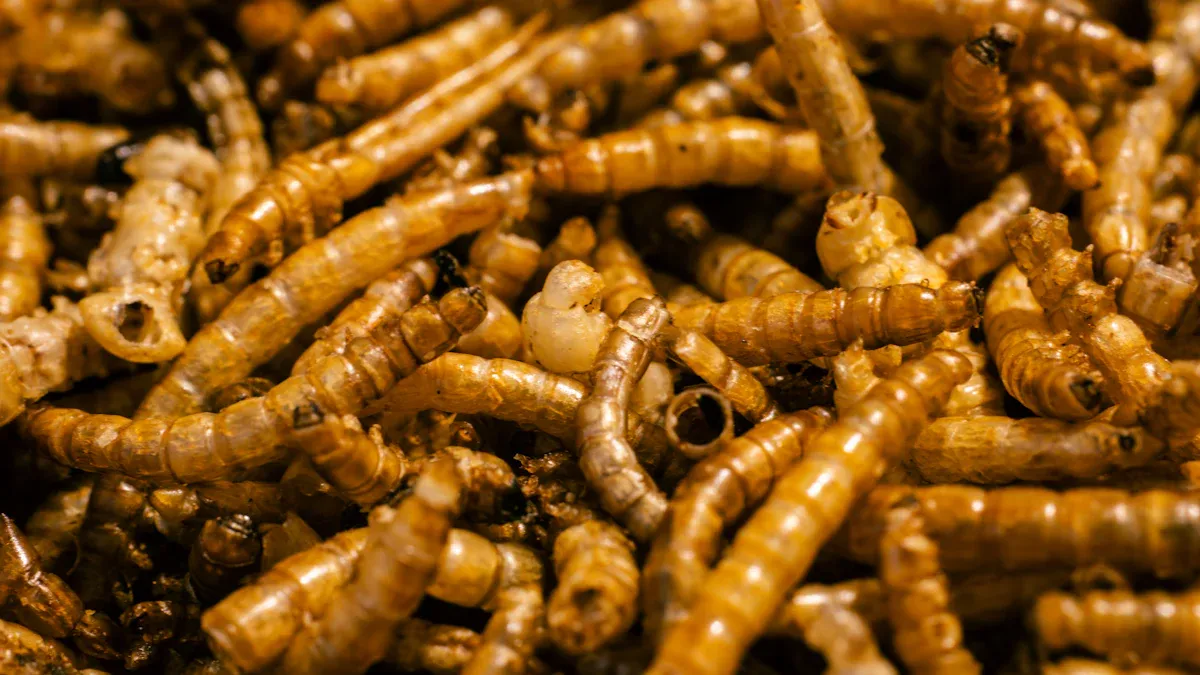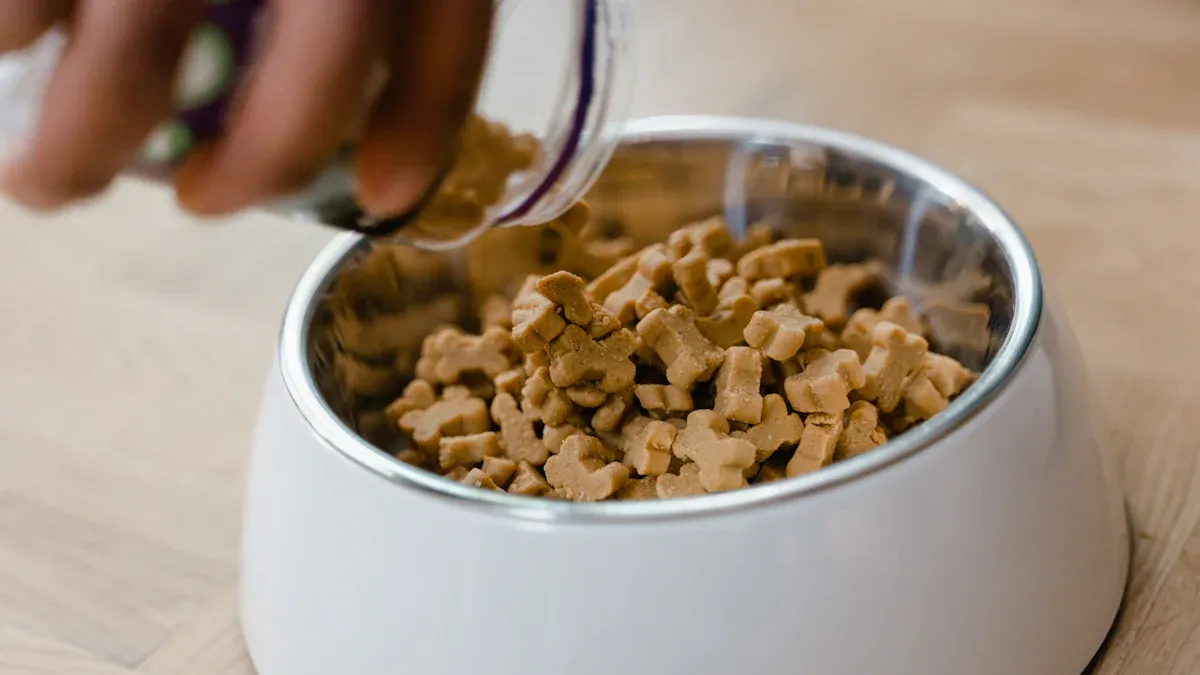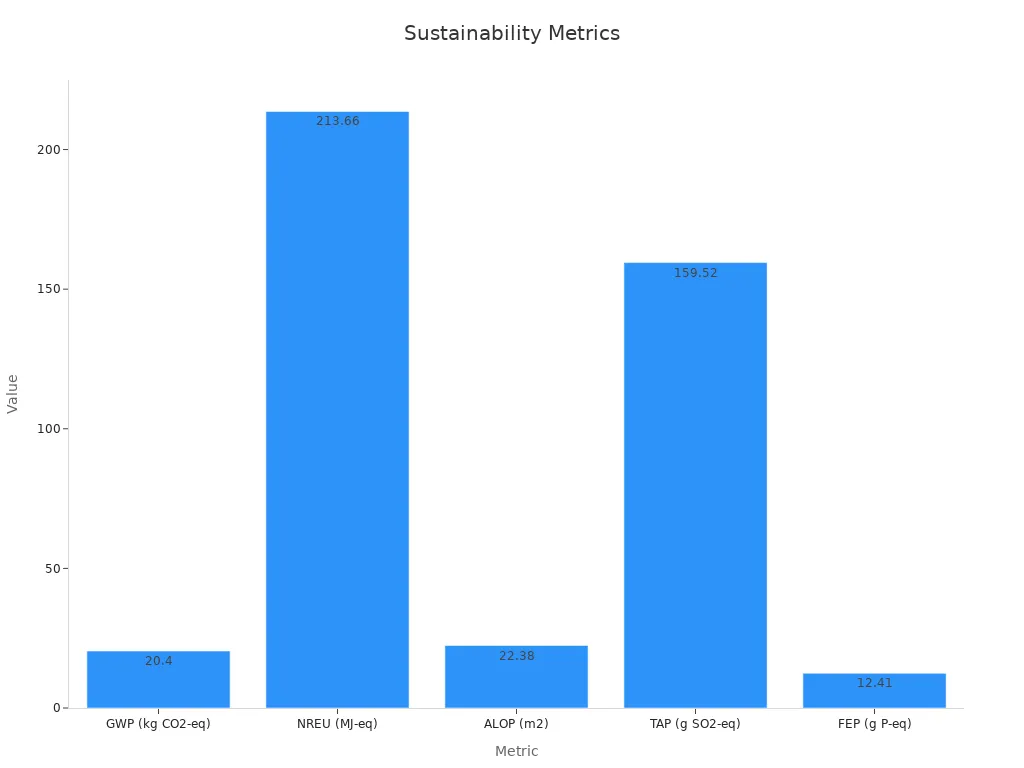
Why are premium dried mealworms for pet food gaining so much attention? They pack a punch when it comes to nutrition, offering high protein and essential nutrients that pets need to thrive. Plus, they’re affordable and eco-friendly. Consider these facts:
- The global mealworms market is projected to hit $1.27 billion by 2030, growing at a staggering 25.8% CAGR.
- Mealworms produce fewer greenhouse gases compared to traditional livestock, making them a sustainable protein source.
For German pet food manufacturers, this means a cost-effective, high-quality ingredient that aligns with sustainability goals.
Key Takeaways
- Premium dried mealworms are healthy and full of protein for pets. They have important amino acids and key minerals pets need.
- Mealworms are affordable and eco-friendly. They use less land and water than farm animals and make fewer harmful gases.
- Adding mealworms to pet food improves quality and taste. It also meets the need for greener and healthier choices.
Nutritional Benefits of Premium Dried Mealworms for Pet

High Protein Content and Essential Nutrients
Premium dried mealworms for pet food are a powerhouse of nutrition. They boast a high protein content, making them an excellent choice for pets that need a protein-rich diet. According to research from Maastricht University, mealworm protein compares favorably to milk protein. It contains all nine essential amino acids, which are crucial for muscle growth and overall health. This makes mealworms a complete protein source, ideal for supporting pets’ active lifestyles.
Mealworms also offer a variety of other nutrients. Studies show they are rich in minerals like calcium, iron, and manganese. These minerals play a vital role in bone health, oxygen transport, and enzyme function. Interestingly, the nutritional profile of mealworms can be enhanced by adjusting their diet, such as feeding them potato cuttings. This adaptability ensures manufacturers can produce mealworms with tailored nutrient profiles to meet specific pet needs.
| Nutritional Aspect | Findings |
|---|---|
| Protein Content | High protein content confirmed through proximate biomass composition analysis. |
| Fat Content | Increased fat content observed when mealworms were fed with potato cuttings. |
| Mineral Content | Enhanced mineral content, particularly calcium, iron, and manganese, noted with specific diets. |
Digestibility and Support for Pet Health
Mealworms aren’t just nutritious—they’re also easy to digest. The protein in premium dried mealworms for pet food is efficiently broken down, ensuring pets can absorb the nutrients they need. Research highlights that mealworm protein stimulates muscle production just as effectively as milk protein. This makes it a fantastic option for pets requiring muscle maintenance or recovery.
Additionally, mealworms contribute to better overall health. They have been shown to reduce cholesterol levels in the liver and plasma, which can support heart health in pets. Their digestibility and nutrient density make them a smart choice for pet food manufacturers aiming to create high-quality, health-focused products.
Did you know? Mealworm farming is not only sustainable but also produces a protein source that aligns with EU safety regulations. This ensures that premium dried mealworms meet the highest standards for pet food production.
Cost-Effectiveness of Premium Dried Mealworms for Pet
Comparison to Traditional Protein Sources
Mealworms offer a unique advantage when compared to traditional protein sources like chicken or fish. Their feed conversion rate (FCR) is comparable to pigs, ranging between 3.8 and 5.8. This means mealworms require less feed to produce the same amount of protein as some livestock. Additionally, they are rich in essential nutrients like iron, vitamin D, and zinc, making them a nutrient-dense option for pet food manufacturers.
From a financial perspective, mealworms stand out. The cost of producing mealworms can be calculated by dividing the price of their substrate by the average weight of mealworms produced. This straightforward metric highlights their cost-effectiveness. Studies also show that mealworm farming delivers a favorable cost-benefit ratio (CBR) and return on investment (RoI), making them an economically efficient choice for manufacturers.
Long Shelf Life and Reduced Waste
One of the most practical benefits of premium dried mealworms for pet food is their long shelf life. Unlike fresh meat, dried mealworms can be stored for extended periods without refrigeration. This reduces the risk of spoilage and minimizes waste, which is a common issue with traditional protein sources. For manufacturers, this means fewer losses and more predictable inventory management.
Mealworms also produce less waste during farming. They require minimal water and land compared to livestock, and their farming process generates fewer byproducts. This makes them an eco-friendly and efficient protein source that aligns with the sustainability goals of many German pet food manufacturers.
Tip: Incorporating premium dried mealworms for pet food into production not only saves costs but also supports a greener future.
Suitability of Premium Dried Mealworms for the German Pet Food Market
Alignment with German Quality Standards
German pet food manufacturers are known for their strict adherence to quality and safety standards. Premium dried mealworms for pet food align perfectly with these expectations. They meet EU safety regulations, ensuring they are free from harmful contaminants and safe for consumption. This compliance makes them a reliable choice for manufacturers aiming to maintain their reputation for excellence.
The growing popularity of insect-based pet food in Germany further highlights their suitability. For instance, EntoNative, a German startup specializing in insect-based dog treats, recently secured EUR1.1 million in seed funding. This investment reflects the increasing demand for innovative, high-quality ingredients like mealworms in the pet food market. With approximately 45% of German households owning pets, the market for diverse and nutritious pet food options continues to expand.
Pet owners in Germany are also drawn to the health benefits of insect-based products. Mealworms, with their high protein content and essential nutrients, cater to this demand. Their digestibility and ability to support pet health make them a standout ingredient in the competitive pet food industry.
Sustainability and Eco-Friendliness of Mealworm Farming
Mealworm farming offers significant environmental advantages, making it an eco-friendly protein source. Compared to traditional livestock, mealworms require less land, water, and feed. They also produce fewer greenhouse gas emissions, aligning with Germany’s commitment to sustainability. The life cycle assessment of mealworm farming highlights its low environmental impact:
| Metric | Value |
|---|---|
| Global Warming Potential (GWP) | 20.4 kg CO2-eq |
| Non-Renewable Energy Use (NREU) | 213.66 MJ-eq |
| Agricultural Land Occupation | 22.38 m² |
| Terrestrial Acidification | 159.52 g SO2-eq |
| Freshwater Eutrophication | 12.41 g P-eq |

These metrics demonstrate that mealworm farming reduces environmental impact by 18-72% compared to traditional protein sources. Additionally, mealworms pose a lower risk of zoonotic diseases, further enhancing their appeal as a sustainable and safe option for pet food production.
The German pet food market is expected to grow steadily, driven by rising pet ownership and the trend of pet humanization. As sustainability becomes a key purchasing factor, premium dried mealworms for pet food provide a perfect solution for manufacturers looking to meet consumer demands while reducing their ecological footprint.
Practical Applications of Premium Dried Mealworms for Pet Food Manufacturers
Incorporating Mealworms into Pet Food Products
Mealworms are a versatile ingredient that pet food manufacturers can easily incorporate into various products. Their high protein content and digestibility make them suitable for dry kibble, wet food, and even treats. Manufacturers can use whole mealworms, defatted mealworm meal, or hydrolyzed protein meal to create products tailored to different pet needs. Research shows that all these forms of mealworm ingredients have a digestibility rate of over 90% for amino acids, except for histidine and valine. This ensures pets receive maximum nutritional benefits.
The rearing substrate of mealworms also plays a crucial role in their flavor profile. Adjusting the substrate can enhance palatability, making mealworm-based products more appealing to pets. For example, freeze-dried Alphitobius diaperinus larvae, which are safe for human consumption, can be marketed as a premium ingredient in pet food. This human-grade quality adds value to the final product and appeals to pet owners seeking high-quality options.
Tip: Experimenting with different mealworm forms and substrates can help manufacturers create unique, palatable products that stand out in the market.
Examples of Successful Use Cases in the Industry
In feline feeding trials, researchers observed that cats showed sensitivity to certain insect aromas, particularly in high-inclusion diets with Hermetia illucens. However, this challenge can be addressed by refining formulations to enhance palatability. The acceptance of mealworm-based products in human food markets across Europe further supports their potential in pet food manufacturing.
Additionally, studies reveal that education levels positively influence farmers’ willingness to adopt mealworms as feed, with a significant coefficient of β = 1.568. This indicates growing awareness and acceptance of mealworms as a sustainable protein source. Companies investing in mealworm-based products can leverage this trend to meet the rising demand for eco-friendly and nutritious pet food.
Note: The high protein content and balanced nutritional profile of mealworms make them a reliable choice for manufacturers aiming to create innovative, health-focused pet food products.
Premium dried mealworms for pet food offer unmatched benefits. Their high protein and healthy fat content make them a nutritious choice for pets. They also require less land and water, producing fewer greenhouse gases than traditional livestock. These qualities align with the sustainability goals of German pet food manufacturers. Exploring mealworm-based products can provide a competitive edge in this growing market.
FAQ
What makes mealworms a sustainable protein source for pet food?
Mealworms require less land, water, and feed than traditional livestock. They also produce fewer greenhouse gases, making them an eco-friendly choice for manufacturers. 🌍
Are mealworms safe for pets to eat?
Yes, mealworms meet EU safety regulations. They are free from harmful contaminants and provide a high-quality, nutritious protein source for pets. 🐾
How can manufacturers use mealworms in pet food products?
Manufacturers can add mealworms to dry kibble, wet food, or treats. They can use whole mealworms, defatted mealworm meal, or hydrolyzed protein meal for versatility. 🍖
Tip: Experimenting with mealworm forms can help create unique, pet-friendly products!


